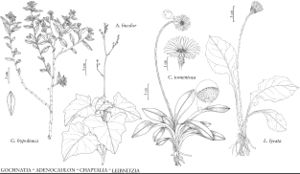Gochnatia
in A. von Humboldt et al., Nov. Gen. Sp. 4(fol.): 15. 1818.
4(qto.): 19. 1820.
| Taxon | Illustrator ⠉ | |
|---|---|---|
 | Gochnatia hypoleuca Adenocaulon bicolor Chaptalia tomentosa Leibnitzia lyrata | Yevonn Wilson-Ramsey Yevonn Wilson-Ramsey Yevonn Wilson-Ramsey Yevonn Wilson-Ramsey |
Subshrubs or shrubs [herbs, trees], 100–400 [–1000+] cm (sometimes dioecious). Leaves cauline; petiolate [sessile]; blades lance-elliptic to lanceolate [elliptic, linear, ovate] (stiff), bases ± cuneate [rounded], margins entire [denticulate to dentate] (often revolute), abaxial faces usually tomentose [minutely stipitate-glandular or gland-dotted and/or hirtellous], adaxial faces usually glabrous or glabrescent. Heads discoid [quasi-discoid or disciform], in ± corymbiform or glomerulate arrays [borne singly]. Involucres obconic or campanulate to cylindric, 5–8 [–15] mm. Phyllaries in 3–10 (–15) series (outer often intergrading with peduncular bractlets), ovate to lanceolate, unequal, apices obtuse to acute. Receptacles flat, smooth or alveolate, usually glabrous, rarely glandular-hairy, epaleate. Florets 4–25 [–150], bisexual or unisexual, fertile [pistillate or functionally staminate]; corollas whitish [cream-colored to yellow], actinomorphic (lobes 5, lanceolate to lance-linear, glabrous); anther basal appendages laciniate [entire], apical appendages lanceolate, rounded to apiculate; style-branches relatively short, apices rounded. Cypselae ± obpyramidal [cylindric or turbinate], not beaked, obscurely ribbed, faces usually ± sericeous to velutinous and/or glandular-hairy; pappi of 20–30+ whitish to stramineous, smooth or ± barbellate bristles and/or setiform-subulate scales in 1–2 series.
Distribution
Mostly tropical and warm North America and South America, West Indies, two species in tropical mountains of southeast Asia
Discussion
Species ca. 68 (1 in the flora).
In an analysis of DNA sequences from a sample of species in Gochnatiinae, H. G. Kim et al. (2002) found that Gochnatia is monophyletic and the subtribe is not. K. Bremer (1994) concluded that Gochnatia is paraphyletic to other genera in Mutisieae. N. Roque and D. J. N. Hind (2001) segregated one species from Gochnatia as a monotypic genus, Ianthopappus.